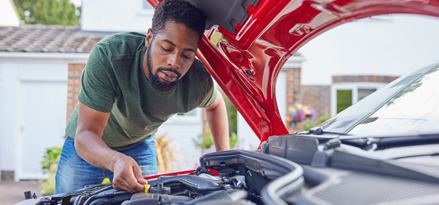Checking your oil regularly is important and can help prevent excess engine wear.
Over time, engine oil begins to degrade, it loses its effectiveness and can no longer provide adequate protection to the engine.
The oil can collect water formed in small amounts during heating and cooling of the engine, dust and dirt entering the engine through the air induction system. The oil can also react with an acid, formed by the reaction of water with other contaminants.
When driving, the contamination of the engine oil increases. The oil filter traps particles contained in the oil, but with time the oil itself begins to break down (oxidize or thicken). From this moment the oil can no longer perform to its optimum capability and so requires replacing.
The oil must be replaced before its contamination will reach a level that could lead to engine damage. Determining the level of contamination within the oil can be very difficult, as a result car manufacturers provide recommended oil change intervals. These recommendations depend on the year of manufacture of the car and make and model.
Ideally, the oil level should be checked every week, as recommended by the most car manufacturers. If the oil level drops from highest to lowest mark in less than 1000 miles, the engine should be checked. Oil consumption depends on the model of the car and driving style.
Items you'll need:
- A clean cloth or rag
- Bottle of motor oil (find out which oil is right for your car)
- A funnel
Step 1 - Park on a level surface
Park the vehicle on a level surface, switch off the engine and wait for 3-4 minutes, until the oil drains into the sump.
Step 2 - Clean the dipstick
Ensure that the engine has cooled off. Pull out the dipstick, use your cloth to wipe off the oil, and then slowly push the dipstick back into its tube.
Step 3 - Check the oil level
Remove the dipstick once more and check the oil level, it should be between the upper and lower marks. If it is closer to the lower one you’ll need to top up your oil.
Step 4 - Top up the oil
If you need to add more oil, put the dipstick back into its tube and remove the cover from the oil filler cap. Slowly pour some oil in, using a funnel if needed and replace the cover.
Wait 60 seconds for the oil to drain into the crankcase, insert the dipstick and check the level again. Add oil if needed and replace the oil filler cap.
Checking and topping up your vehicle’s oil is clearly important in helping to prevent excess engine wear and damage. However one of the most important things you can do to keep your car running in the best condition possible is to change your vehicle’s engine oil and filter.
Our step-by-step guide takes you through how to do this.
Park the vehicle on a level surface, switch off the engine and wait for 3-4 minutes, until the oil drains into the sump.
Step 2 - Clean the dipstick
Ensure that the engine has cooled off. Pull out the dipstick, use your cloth to wipe off the oil, and then slowly push the dipstick back into its tube.
Step 3 - Check the oil level
Remove the dipstick once more and check the oil level, it should be between the upper and lower marks. If it is closer to the lower one you’ll need to top up your oil.
Step 4 - Top up the oil
If you need to add more oil, put the dipstick back into its tube and remove the cover from the oil filler cap. Slowly pour some oil in, using a funnel if needed and replace the cover.
Wait 60 seconds for the oil to drain into the crankcase, insert the dipstick and check the level again. Add oil if needed and replace the oil filler cap.
Checking and topping up your vehicle’s oil is clearly important in helping to prevent excess engine wear and damage. However one of the most important things you can do to keep your car running in the best condition possible is to change your vehicle’s engine oil and filter.
Our step-by-step guide takes you through how to do this.
Viscosity is a measure of the resistance of a fluid’s flow. The thicker (high viscosity) of an oil, the slower it will flow.
Most oils on the shelves today are "Multigrades", which simply means that the oil falls into two viscosity grades (i.e. 10W-40 etc). In a 10W-40 for example the 10W bit (W = winter) simply means that the oil must have a certain maximum viscosity or flow at low temperature. The lower the "W" number the better the oil's cold temperature performance.
The 40 in a 10W-40 simply means that the oil must fall within certain viscosity limits at 100°C. This is a fixed limit and all oils that end in 40 must achieve these limits. Once again the lower the number, the thinner the oil: for example, a 30 oil is thinner than a 40 oil at 100°C.
The oil light may come on for a variety of reasons, typically this is due to there not being enough oil in the system, reasons for this could include; oil pump failure, failure of the oil pressure sensor, or a blockage in the oil system.
If the light comes on when at speed, do your best to pull off the road quickly and safely and turn the engine off as soon as possible. Continued operation of the engine with low oil pressure can cause serious damage to the engine.
-

Mobil 1™
Our advanced range of synthetic technology engine oils helps provide outstanding engine protection against wear. Nothing works harder for your car.
More about Mobil 1™ -

Mobil Super™
Mobil Super™ offers a range of synthetic, semi-synthetic and conventional oils providing different levels of protection to match the conditions you face, whilst always ensuring you can drive with full confidence.
More about Mobil Super™ -

How to care for your car
If you want your car to have reliable performance and remain in top condition, you need to take good care of it. With just a few quick maintenance checks, alongside regular services, you can keep your car running for longer.
Learn more

